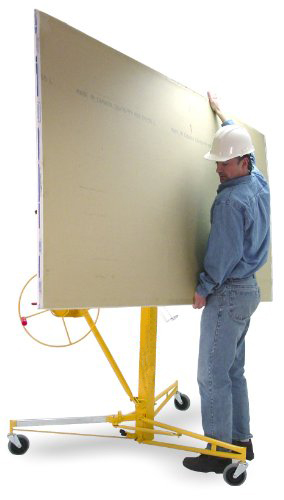
The Wrong Way of Using Drywall Lift
Keyword:Drywall Lift Time:2019-3-4 23:23:02
This is a report on the results of studies on the instability of workers' postures when lifting or hanging plaster boards.
August 2000
According to statistics from the Bureau of Labor Statistics, falls account for 32% of traumatic injuries among dry wall erectors (1992-1995). Falling is an important factor leading to fracture, muscle and skeleton injury and even death. Drywall lifting and hanging tasks require workers to deal with heavy dry wall panels and maintain clumsy postures so that materials can be installed on walls or ceilings. Previous studies have shown that dry wall lifting and hanging operations cause more fall-related injuries than other operations. Activities associated with these two tasks often lead to muscle fatigue and a tendency to lose balance.
In addition, because dry wall installers often work at high altitudes, they face a high risk of falling. The purpose of this study was to investigate the postural instability of workers when lifting or hanging gypsum boards. Forty-seven construction workers (average age = 34.7 + 9.1 years) with at least six months of dry wall installation experience (average experience = 9.1 + 6.8 years) participated in this study. Each participant used one of four lifting methods for four times: 1) vertical lifting of the dry wall; 2) horizontal lifting of the dry wall with both hands on the top of the dry wall; 3) horizontal lifting of the drywall with both hands on the bottom of the dry wall; 4) horizontal lifting of the dry wall with one hand on the top and one hand on the bottom. Subjects were also asked to perform four suspension tests using one of four suspension methods: 1) hanging vertically on the wall; 2) hanging horizontally on the wall; 3) hanging vertically on the ceiling; and 4) hanging horizontally on the ceiling. This study is a completely randomized design. Each participant was randomly assigned lifting and suspension methods. A piezoelectric force platform was used to quantify the postural instability of workers. Two attitude swing variables (swing length and swing area) and two indicators (near stable boundary index (IPSB) and stable area ratio (SAR) were used to describe the tendency of workers to lose balance in the process of lifting and suspension of dry wall. The variance analysis showed that different lifting modes had significant effects on two postural swing variables (mean P < 0.001) and two postural instability indices (mean P < 0.002). It was found that the horizontal lifting of the dry wallboard with both hands at the bottom of the dry wall caused significantly greater postural swing and instability than that with both hands at the top of the dry wall (all P < 0.01). Posture swing and instability associated with horizontal suspension on the ceiling are greater than that associated with vertical suspension on the wall or horizontal suspension on the wall (all P values are less than 0.001). All simulated dry wall lifting and suspension tests were carried out on the ground. If a worker lifts and hangs a dry wall at high places such as ladders, scaffolding and stilts, the posture swing and instability of the worker may be more intense, leading to higher risk and severity of falling. The results show that in order to minimize the instability of posture, workers should avoid putting their hands on the bottom of the wallboard and lifting the dry wallboard in a horizontal position. Workers should also avoid hanging dry wallboards horizontally from the ceiling (Method 4).


- No information
-
1. Design objective of electronic crane scale network management. (1) Adopt advanced distributed data processing techno…
-
Electronic crane scale bearing platform installation to focus Electronic crane scale can be installed generally on the li…


